#carafa
Text

Allegra Amanda, Princess Caracciolo-Carafa || Phillipa Lepley
11 notes
·
View notes
Text

TIARA ALERT: Allegra Amanda wore a diamond tiara for her wedding to Prince Gianni Caracciolo-Carafa at the Carafa Chapel of the Basilica Santa Maria sopra Minerva in Rome, Italy on 5 June 2022.
#Tiara Alert#Princess Caracciolo Carafa#Italy#Italian Nobility#Italian Aristocracy#bridal tiara#diamond#tiara#tiaras#diadem#diadems
66 notes
·
View notes
Text
Libri: B. Carafa, La vita involontaria, Cliquot
Rosa Ghislandi ci segnala il romanzo della Carafa, premio Strega del 1975.
Rosa ci scrive: “E’ la voce di un giovane uomo a guidare le vicende della formazione di Pintus: studente svogliato di filosofia , più per compiacere ad un desiderio altrui che per urgenza sua. A pensione da una vecchia signora, innamorato respinto, sprezzante, dopo una crisi esistenziale viene iniziato alla psicoanalisi…

View On WordPress
0 notes
Text
Saxophone History Podcast Episodes 1 & 2
I’m very pleased to be publishing the first couple of episodes of a new podcast I’ve been working on for a while. It’s called The Saxophone History Podcast and the idea is to take a look at the lives of the most interesting people who have played the saxophone throughout history. It’s a thoughtful, researched, and slightly irreverent look at our collective history as saxophonists. I’m going to…

View On WordPress
#Adolphe Sax#andrew d meyer#Andrew Meyer#Belgium#D&039;Indy#Debussy#Elise Hall#France#French Military#Loeffler#Michele Carafa#Military Bands#Paris#saxophone#Saxophone History Podcast
0 notes
Text
La muta di Portici
Daniel Auber (29 gennaio 1782 - 1871): Ouverture per l’opera La Muette de Portici (1828). Symfonický orchester Slovenského rozhlasu v Bratislave (Orchestra sinfonica della Radio slovacca di Bratislava), dir. Ondrej Lenárd.
Per la composizione, Auber si avvalse inizialmente di un libretto di Germain Delavigne intitolato Masaniello, ou la Muette de Portici; il testo fu poi riscritto da Eugène…
youtube
View On WordPress
#Daniel Auber#Eugène Scribe#Germain Delavigne#Michele Carafa#Ondrej Lenárd#Symfonický orchester Slovenského rozhlasu v Bratislave#Youtube
1 note
·
View note
Text
Nina podcast su Brianna Carafa a cura di Anna Toscano
Nina podcast su Brianna Carafa a cura di Anna Toscano
La sesta puntata di NINA a cura di Anna Toscano è dedicata alla scrittrice Brianna Carafa. Hanno contribuito Ilaria Gaspari, sulla figura della scrittrice e sul romanzo La vita involontaria, Flavia Capone sulla raccolta di racconti Gli angeli personali, Anna Toscano sulle poesie, Federico Cenci sul lavoro di riscoperta e ripubblicazione dell’opera di Brianna Carafa.
NINA è il podcast della…

View On WordPress
1 note
·
View note
Photo
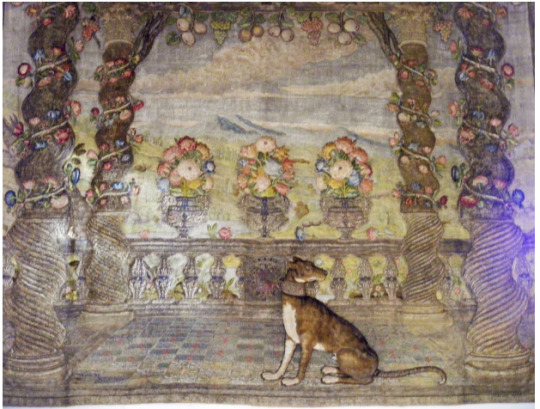
The Vestments of Guzman-CarafaMAN – Museo Arqueologico National – Madrid
The series is composed by seven square shaped cloths which measure 4,77m x 4.06m, and two pieces of 4,77m x 2,31m. The background is emboidered in various colors, and shows paddings and applications in relief, in particular in the columns and in the animals in the close-up. On every cloth there is a pergola composed of a canopy on four columns within which is represented some animals that are the protagonists: a deer, a ram, a leopard, a greyhound, a lion, a bear that bites a dog, a puppy and a monkey that plays with fruit.The coat of arms of the Guzmàn-Carafa family between the columns indicates the commitment in the years of the marriage with the princess of Stigliano, between 1636 and 1644.
the #sighthound #bulletin
0 notes
Text
Secondo Emeritus - Naples
Primo | Secondo | Terzo

Naples. My beautiful Naples. My beloved, adored Naples. It is the city where I studied and grew up in and it is also literally filled with mysteries and legends.
I thought Naples would have been the perfect formation place for a young Secondo Emeritus. Let’s see what may have influenced and inspired him in his religious journey.
1 - The musical church.

Ghost’s music has always been heavily loaded with the Devil’s Tritone: also called Diabulus in Musica or Devil’s Interval, it is an unsettling dissonance produced by an unusual arrangement of notes that gives that spooky, devilish tone to music. In Infestissumam, it was featured on 9 out of 10 songs. The use of the Tritone was banned in Medieval times (In Ghost, its use dramatically dropped with Prequelle, with only 2 out of 10 songs featuring it). So what if I tell you that, in contrast, in Naples there is a church that functions as a musical score, whose music protects it from evil?
Basically, there is a church in Piazza del Gesù that has a particular pointy ashlar on the external facade. Under the side (the one facing the ground, so if you look up from the street you can see them) of each of these little pyramids are carved symbols, which turned out to be Aramaic letters that were later translated into musical notes. So, it turned out that the whole church is a big score, and it’s playable. The whole melody, called Enigma, was played for the first time inside the church to celebrate the discovery. You can hear the music here (sound quality is not the best).
Will it protect the church from Ghost’s music?
2 - The skull cult.

Naples has very intricate underground galleries, almost all visitable. One of these is Cimitero delle Fontanelle, a famous catacomb where the remains of about 40.000 people who died from plagues are stored. It is said the “anime pezzentelle” cult was born here: it is a particular relationship each Neapolitan establishes with a chosen skull. You literally adopt an abandoned skull, which according to our tradition is the seat of the soul, and your duty is to care for it, protect it and also create a special niche for it. In exchange, the soul of that skull will protect you.
A nice place for a Bone Daddy.
3 - Pretty and Evil like Mergellina’s devil.
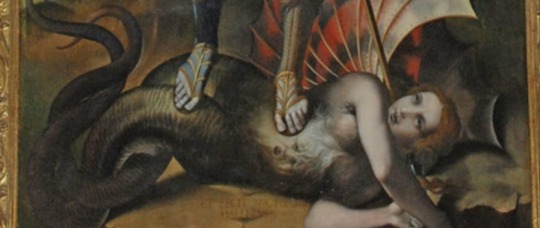
Knowing the passion our Secondo has for women, here is a story about a very devilish one.
In Santa Maria del Prato church, in the Mergellina area, there is the only representation of the devil as a woman in a painting.
The legend has it that said woman was the beautiful Vittoria D’Avalos, who seduced the Bishop Diomede Carafa, who commissioned the painting in 1542 to represent his victory against the woman’s lust (we're all believing him, right? 🙄).
Now that story has a way of saying that refers to femmes fatales as “Pretty and Evil like Mergellina’s devil”.
I’d say she may be considered among the first-ever Sisters of Sin.
4 - Who gives life can also take it.
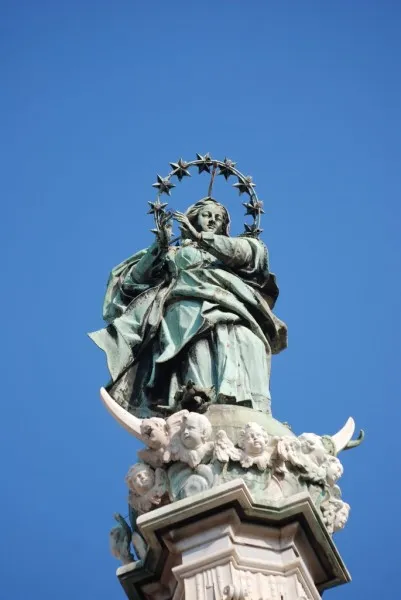

Infestissumam is filled with references to birth and Jesus, turning it into the birth of the antichrist and creating a narrative that is completely opposite to the birth of the Son of Man. Now, in Naples, there is a statue that embodies both concepts.
Back to Piazza del Gesù: On a very high pedestal in the center of the square stands a statue of the Virgin Mary, the Mother. That's all... until you position yourself at a specific point in the square and look up to see the statue transformed into the Reaper. His face is hidden by the cowl, staring straight at you, with a sickle at its feet and a snake crawling on it.
Depending on your point of view, the giver of life becomes the taker of it.
5 - Body and Blood… but especially blood.

What never stops to fascinate me about the relationship of Neapolitans with religion is the very thin line between devotion and pure blasphemy. It is the case of the “miracle” of San Gennaro’s blood. It happens twice a year and it consists in bringing the Saint’s blood in a liquid state again (after centuries it is obviously solidified). The particular thing is that during this ritual, the worshippers (and the priests too) literally insult the saint to convince him to make the miracle happen, because if it doesn’t work, it means that something terrible is about to happen.
(Last time it didn’t work was right before the Covid pandemic 🙂)
I’d say this could have been a great inspiration for Body and Blood and Idolatrine.
Honorable mention to the fact that I have lived 32 years now on this Earth and I never attended this event even though I would like to.
Bonus: Now, I said that Dante would come back in the chapters, and he is. In fact, not only Virgilio died in Naples (and he is the protector of the city) but, apparently, the gates of Hell Dante mentioned in his comedy were located on the Averno lake, near Pozzuoli, not far from Naples.
#the band ghost#ghost theory#papa emeritus ii#secondo emeritus#secondo#papa secondo#ghost fandom#Italian cities#ghost band theories
108 notes
·
View notes
Text






Palazzo Diomede Carafa (XV sec.), San Biagio dei Librai, Napoli.
#napoli#naples#art history#art#campania#southern italy#arte#sculpture#architecture#renaissance#italian renaissance
111 notes
·
View notes
Text

“Princess Caracciolo-Carafa’s wedding dress is how you do a fresh Grace Kelly inspired dress without being a copycat or old-fashioned” - Submitted by Anonymous
25 notes
·
View notes
Text
THIS DAY IN GAY HISTORY
based on: The White Crane Institute's 'Gay Wisdom', Gay Birthdays, Gay For Today, Famous GLBT, glbt-Gay Encylopedia, Today in Gay History, Wikipedia, and more … March 29



1517 – Cardinal Carlo Carafa, (d.1561) who was born in Naples, was the younger son in a powerful noble family. He became a soldier and for seventeen years took part in the bloody wars which ravaged Italy, first on the side of the Habsburg imperial armies, afterwards with French troops.
His uncle, Gian Piero Carafa was elected pope, with the name of Paul IV, and made Carlo a cardinal in 1555.
Carlo Carafa had a long and dubious career as a mercenary soldier in Italy and Germany. He was exiled from Naples for murder and banditry and was alleged to have perpetrated the massacre of Spanish soldiers as they recuperated in a hospital in Corsica.
His tenure as Cardinal Nephew was not a great success as he and Paul IV brought the Papacy to a humiliating defeat against the Spanish that nearly resulted in another Sack of Rome. Carlo's government was unpopular in Rome and he developed a reputation for avarice, cruelty and licentiousness, as well as for sodomy.
For instance the cardinal Charles de Lorraine asked the French ambassador in Rome to report to the pope scandals concerning his nephews. In his letter he stated that the courtiers had been scandalized by what they had witnessed, "and among the culprits were openly numbered, those who were closest in blood relations to our Holy Father the pope" had engaged in "that sin so loathsome in which there is no longer a distinction between the male and the female sex." That is, sodomy.
These rumors cannot be explained away as political slander. Already the poet Joachim du Bellay who was then in Rome, wrote a sonnet mentioning one Ascanio as the beloved of Carlo Carafa.
At first the pope refused to believe the numerous and varied accusations, but he was finally convinced of their veracity. and replaced Carlo as Cardinal Nephew with Carlo's own nephew Alfonso Carafa.
With the death of Paul IV, who had already limited a part of his power, he was imprisoned and judged by the new pope, Pius IV , for a lengthy series of crimes ranging from homicide to heresy, which also included sodomy. Carlo was condemned and executed.


1905 – Edward Burra, a British illustrator and stage designer (d.1976), depicted the possibility of gay sexual encounters in his drawings and watercolors of the urban underworld.
He left school at thirteen because of a combined attack of anemia and rheumatic fever. Burra's parents worried that that their son was too sickly for a regular job and encouraged his artistic interests.
Burra was not openly gay, but he visited gay bars, had gay friends, and possessed a camp sensibility. He met the dancer and theatrical director William Chappell at Chelsea and the two were apparently lovers although they never lived together. Burra may also have been involved with artist Paul Nash in the 1920s.
Burra, from an upper-class family, had a fascination with the lower class and with the urban underworld. He loved to spend hours in sailors' cafes and brothels in Mediterranean port cities, especially in France. He visited New York in 1933-34, where he became fascinated with black culture and the Harlem scene.

Three Sailors in a Bar
Typically featuring sailors, his early works portrayed clearly outlined and modeled forms and an absence of atmosphere. While Burra very rarely draws explicitly gay scenes or subjects, a homoeroticism pervades his work, perhaps because in his depictions of urban nightlife, sexual liaisons of various kinds are always a possibility.
Burra's most famous work, John Deth (1932), shows his interest in the bizarre. The painting depicts a party. The scythe-bearing Grim Reaper is in attendance, and he is striking down guests, much to the horror of one man who dips his partner in a dance at the moment that he recognizes the presence of Death. The faces and figures are distorted in a nightmare characterization typical of Burra's work.
Plagued by arthritis and poor health, Burra died on October 22, 1976 in Hastings, England.


1936 – Today's the birth date of the English composer Sir Richard Rodney Bennett, CBE (d.2012). Born in Kent, he is renowned for his film scores and his jazz performance as much as for his challenging concert works. He was based in New York City from 1979 until his death there in 2012.
After the collapse of a long-term same-sex relationship, Bennett relocated to the U.S., using Stephen Sondheim and Leonard Bernstein as his referees for his green card application. Bennett thrived in the home of the Great American Songbook. He began performing in piano bars and has continued ever since, in recent years accompanying the jazz singer Claire Martin, most recently in a season at the legendary Algonquin hotel.
Bennett taught at the Royal Academy of Music between 1963 and 1965, and the Peabody Institute in Baltimore, United States from 1970 to 1971, and was later International Chair of Composition at the Royal Academy of Music between 1994 and the year 2000. He received a CBE in 1977, and was knighted in 1998.
As one of Britain's most respected and versatile musicians, Bennett produced over two hundred works for the concert hall, and fifty scores for film and television, as well as having been a writer and performer of jazz songs for fifty years.
Among his best-known scores are the Doctor Who story The Aztecs (1964), Far from the Madding Crowd (1967), Nicholas and Alexandra (1971, for which he was nominated for an Academy Award), Murder on the Orient Express (1974), Enchanted April (1992) and Four Weddings and a Funeral (1994).
In 1995, to celebrate its 200th issue, Gay Times magazine published a list of people regarded as important to the British Lesbian and Gay community. Bennett was named as one of the key musical figures on the list.

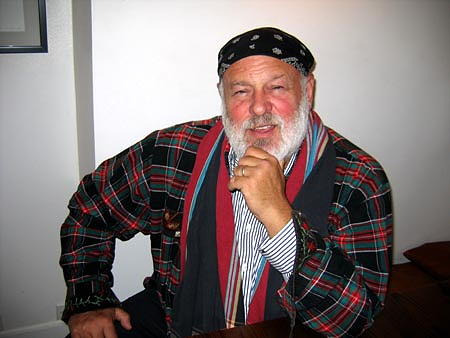
1946 – Bruce Weber is an American photographer and occasional filmmaker. If you have ever gazed longingly at the models in an ad for Calvin Klein underwear or Abercrombie & Fitch, you have probably been looking at the work of photographer, Bruce Weber.
Born in Greensburg, Pennsylvania, Weber became one of the most influential and successful fashion photographers of the 1980s and continues to be one of the world`s most successful commercial photographers.
Weber's fashion photography first appeared in the late 1970s in GQ magazine, where he had frequent cover photos. Soon known as a pioneer of modern male fashion and art photography, he came to the attention of the general public in the late 1980s and early 1990s with his advertising images for Calvin Klein. His straightforward black and white shots, featuring an unclothed heterosexual couple on a swing facing each other, two clothed men in bed, and model Marcus Schenkenberg barely holding jeans in front of himself in a shower, catapulted him into the international spotlight. His photograph for Calvin Klein of Olympic athlete Tom Hintnaus in white briefs is an iconic image.

His nostalgic, usually black and white photography, which manages to be boldly erotic and yet somehow innnocent, played a major role in the resurgence of the male body in advertising - his influence is everywhere. He has changed the way we look at male beauty.
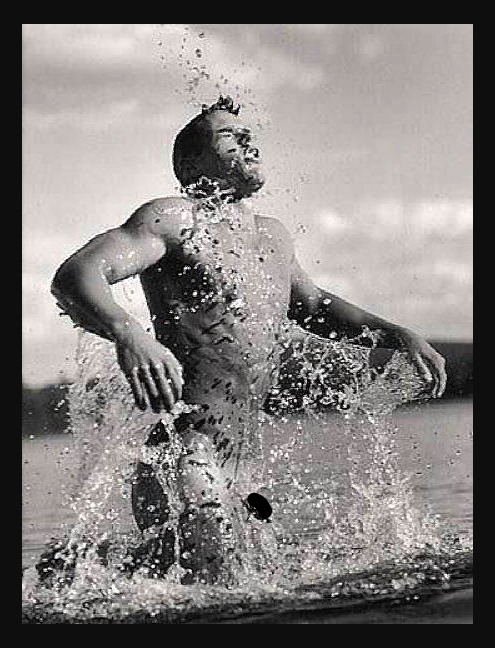
In addition to his commercial work, Bruce Weber has produced several books of his photographs, often photographic essays, notably The Andy Book (1987) and Bear Pond (1991); made several films including a film about teenage boxers Broken Noses (1987), a documentary about jazz trumpeter Chet Baker, Let's Get Lost (1989) which was nominated for an Academy Award, and Chop Suey (2001). His work has also been widely exhibited in museums and galleries. He has additionally directed several music videos for the Pet Shop Boys.

"Laine and Kyle Carson"
His work, and advertising for Calvin Klein, Ralph Lauren and Abercrombie & Fitch and others, somehow manages to balance an intense homoeroticism with an imagined ideal of all-American platonic male cameraderie. Gay men everywhere owe a debt to him.


1958 – Victor Salva is an American film director and convicted sex offender. He is best known for directing the films Powder and Jeepers Creepers.
Born in Martinez, California, Salva had written and directed over 20 short and feature films before graduating from high school. To finance his filmmaking hobby, he often held two jobs during the week. His biological father abandoned the family and Salva stated that his stepfather was often drunk and physically abusive.
Like a lot of children growing up in the East Bay town of Martinez in the early 1970s, the adolescent Salva was very much interested in horror and sci-fi. His favorite monster movie was Creature from the Black Lagoon. In 1975, the local newspaper reported that a child (Salva) had sat through Jaws a record 55 times. Salva was expelled from the family at eighteen when he acknowledged his homosexuality to his mother and stepfather.
Salva describes his films as "atmospheric and macabre, with no happy endings, but not to be taken totally seriously". In the mid-1980s, his 37-minute short film Something in the Basement (1986) took first place in the fiction category at the Sony/AFI Home Video Competition. A horror allegory about a young boy awaiting his brother's return from a bloody war, the highly acclaimed film went on to win several national awards (including a Bronze Plaque at the Chicago International Film Festival) and brought Salva to the attention of Francis Ford Coppola, who then produced Salva's first theatrical feature, Clownhouse (1989), which Salva again wrote and directed.
In 1988, Salva was convicted of sexual misconduct with one of Clownhouse's underage stars – a 12-year-old boy – including videotaping one of the encounters. Commercial videotapes and magazines containing child pornography were also found at his home. Salva pleaded guilty to lewd and lascivious conduct, oral sex with a person under 14, and procuring a child for pornography. He was sentenced to three years in state prison, of which he served 15 months. He completed his parole in 1992.
Salva's career took a hiatus after his release – he did not make another film for five years. He worked as a telemarketer during the week and wrote scripts during the weekend, supposedly delivering them to well-known producers while posing as a delivery boy.
His next film, The Nature of the Beast (1995), which Salva wrote and directed, starred Lance Henriksen and Eric Roberts and quickly became New Line Cinema's biggest direct-to-video title of that year. Salva based the film's characters on people he met in prison. Salva next made his first big-studio picture, Powder (1995), the tale of an albino boy with special powers that make him an outcast.
He next made Rites of Passage (1999), a coming-of-age thriller. The film depicts a homophobic father who unwittingly pushes his gay son into the arms of a psychotic killer. In 2001, Salva wrote and directed Jeepers Creepers, which was one of the year's breakout hits and set a world record for largest Labor Day box-office ever. Salva followed this up with his sixth feature film, Jeepers Creepers II (2003), breaking his old record and setting another Labor Day milestone. His next film, Peaceful Warrior (2006), was an adaptation of Dan Millman's best-seller The Way of the Peaceful Warrior.


1967 – Michael Link, born in Hagen, Germany, is a German music manager and author. He is best known as the manager and partner of the pop singer Patrick Lindner.
After training as a hotel manager and a few years in the hotel business, Link met Patrick Lindner in 1992 and took over his management in January 1993.
Link and Lindner became a couple privately and professed their homosexuality. The media spoke of the nation's flagship gay couple. In 1998, his partner adopted Daniel, a Russian child, who was eight months old at the time, and thus became a pioneer in matters of gay relationships and children. Link wrote the book "Adoption Adventure or A Lifelong Dream Come True", with which he campaigned for more tolerance towards homosexuals and encouraged adoption. In 2005 the couple separated.
In 2001 he also published the children's book “Come on, I'll show you my parents”. He also played in various television series such as SOKO 5113 or Siska. Today Link works as a marketing expert and lives with his current partner in Munich.
Link married his 13 years younger partner in September 2015. The wedding was part of the television series 4 Weddings and a Dream Trip.


1971 – Aaron Lawrence is an American gay pornographic actor, director, sex advice columnist, author and entrepreneur. After college Lawrence embarked on an unplanned male hustling career which he parlayed into both a writing and acting career. Lawrence, who is openly gay then started his own gay pornographic video company utilizing his international travels as an escort to shoot amateur pornography films. He has authored two books, Suburban Hustler: Stories of a Hi-Tech Callboy (1999), an account of his own experiences as a male escort and The Male Escort's Handbook: Your Guide to Getting Rich the Hard Way (2000), a "how-to" guide for those considering work as companions-for-hire. He has also written articles for several publications, including Anything That Moves and Unzipped.
After graduating from college Lawrence became depressed after a string of "100+ rejection letters", he became promiscuous and noting he was good at sex someone suggested he become a male hustler, which he did. He commanded an hourly rate of more than $350, which was much higher than average, which he attributed to his devotion to customer and self-satisfaction as well as his well-developed website, "By the time someone calls me for an appointment they already know who I am."
Lawrence worked in escorting from December 1993 to 2006. In addition to travel throughout the U.S., he traveled with clients on trips to Mexico and several locations in Europe, including Hungary, Germany, Ireland, and the Czech Republic.
Lawrence is versatile performing both top and bottom sex roles. Psychologist Todd G. Morrison notes that Lawrence came of age when being gay was seen as normal and HIV/AIDS was no longer defined culturally as a gay disease. In addition, in the mid-1990s the first AIDS "drug cocktails" marked a dramatic turning point in the pandemic so that a positive diagnosis was no longer considered a death sentence.[
Morrison notes the advent of the Internet for gay men to discover their sexuality and connect with each other online and that Lawrence is the embodiment of the "new experience of gay sexuality" much like Scott O'Hara, Tim Miller, and Wakefield Poole had been for their generations. Between his own work including promotions to advertise himself and his speaking and writing about the gay and bisexual escort industry Lawrence has helped revolutionize the public relation aspects.
He lives in suburban New Jersey with his husband Jeff whom he met in 1992, married in 1999, and who also helps provide illustrations for his various websites.


1982 – Jay Brannan is an American singer-songwriter and actor. He was born in Texas on this date and briefly studied in Ohio, but moved to California to become an actor. Brannan appeared in the 2006 movie Shortbus, which included one of his songs in its soundtrack, and began to build a fan base by performing on YouTube. He released an EP and acted in Holding Trevor in 2007. Since then, he has toured and released two albums.
Brannan was born 1982 in Texas in a middle-class family and grew up as the son of a petroleum engineer and a teacher. He described his family as conservative Baptists and discussed their difficulty with accepting his homosexuality. Brannan went to Los Angeles, trying to become an actor. After the end of a relationship in 2002, he was shown a casting notice and moved to New York City and submitted an audition tape.
Brannan was cast in 2003 for the movie Shortbus, which featured him in an explicit sex scene, and worked as a proofreader and in other jobs to support himself. He contributed the song "Soda Shop" to the film's soundtrack, which he stated was his "first professionally recorded track". The song was also released on Team Love Records. Brannan began to record sparse music videos for YouTube, accompanying himself on the guitar, and built an international fan base without corporate sponsorship, using MySpace and Blogspot. In 2007, he appeared in the movie Holding Trevor as the promiscuous best friend of the protagonist, and released a limited-edition EP with fours songs named disasterpiece or Unmastered, adding two additional songs for a 2008 re-release.
In July 2008, Brannan released the album goddamned through his own label, Great Depression Records, and toured ten dates, a departure from his previous practice of short tours of about four concerts. The same year, Brannan left his proofreading job and sustained himself with earnings from concerts and merchandise. His second album, In Living Cover, was released in 2009 and reached number ten on the Billboard Top Heatseekers chart for the week of July 25, 2009. Brannan promoted the album in an interview on ABC News's Now in July 2009.


2009 – On this date Lieutenant Daniel Choi, publicly came out on the Rachel Maddow Show. Lieutenant Dan Choi is a United States Army combat veteran of the Iraq war who graduated from the United States Military Academy at West Point in 2003 with degrees in Environmental Engineering and Arabic languages. With the three words "I AM GAY" Choi ended his military career . He received a letter from the U.S. Army informing him that he was being dismissed. It says, in part,
"This is to inform you that sufficient basis exists to initiate action for withdrawal of federal recognition in the Army National Guard for moral or professional dereliction. Specifically, you admitted publicly that you are a homosexual, which constitutes homosexual conduct. Your actions negatively affected the good order and discipline of the New York Army National Guard."
He recalls:
"When I got the letter, I was extremely angry. I was angry -- I mean, the letter is basically saying bottom line, Lieutenant Dan Choi, you're fired. You're a West Point graduate, you're fired. You're an Arabic linguist, you're fired. You deployed to Iraq, you're willing to deploy again, doesn't matter. Because you're Gay, that's enough grounds to kick you out. But the biggest thing that I'm angry about is what it says about my unit. It says that my unit suffered negative good order -- negative actions -- good order and discipline suffered. That's a big insult to my unit.
"I mean, all the insult that the letter can do, to say that I'm worthy of being fired, you know, that's nothing comparing to saying that my unit is not professional enough, that my unit does not deserve to have a leader that is willing to deploy, that has skills to contribute."


2014 – At the stroke of midnight, gay marriage became legal in England and Wales. Among the first to tie the knot were Peter McGraith (left) and David Cabreza, who have been partners for 17 years. They were married at Islington Town Hall in the presence of friends, campaigners, well-wishers, and gay activist, Peter Tatchell.


TODAY'S GAY WISDOM:
Almost a year almost after Dan Choi publicly came out on the Rachel Maddow Show in 2009, he returned to speak about the previous year, the continuing fight against "Don't Ask Don't Tell" and his being handcuffed to the White House gates as a public protest. He spoke about the need to be honest and live for the truth of our lives. We reprint his comments here as a reminder that even though DADT has been officially revoked, our LGBT brothers and sisters who are serving in the military are still living in its shadow.
"What the soldiers really respect the most and what they demand of their leaders is not to be of a certain orientation or a certain race or of a certain religion. They want to see courage. They want to know that the leader can step up and speak the truth when it needs to be spoken. And I speak the truth for all these other people who cannot speak up for themselves. That's what they respect. So there's no negative impact. When people can be honest about themselves it's always a positive impact.
"I knew that when I was on that fence I was not alone. When I had those chains on me, on my waist and the fetters and shackles on my legs, for the first time I knew that on the outside it matched what was on the inside: having to live in the closet and to suffer through "Don't Ask Don't Tell." And I see so many stand up and say "You know what? I am somebody and I deserve full equality." And that's what we intend to fight for."- Dan Choi


14 notes
·
View notes
Text



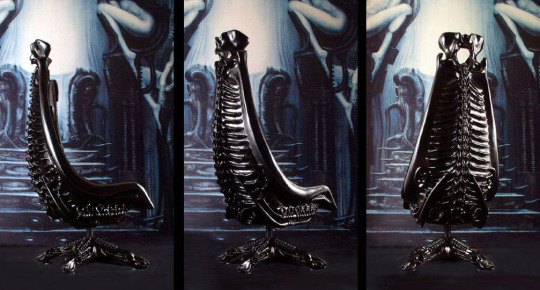
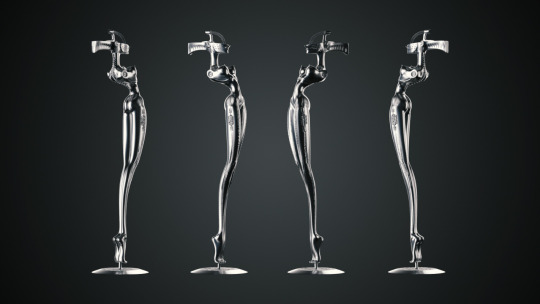

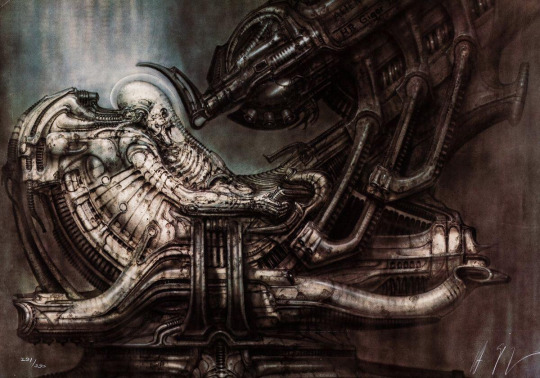


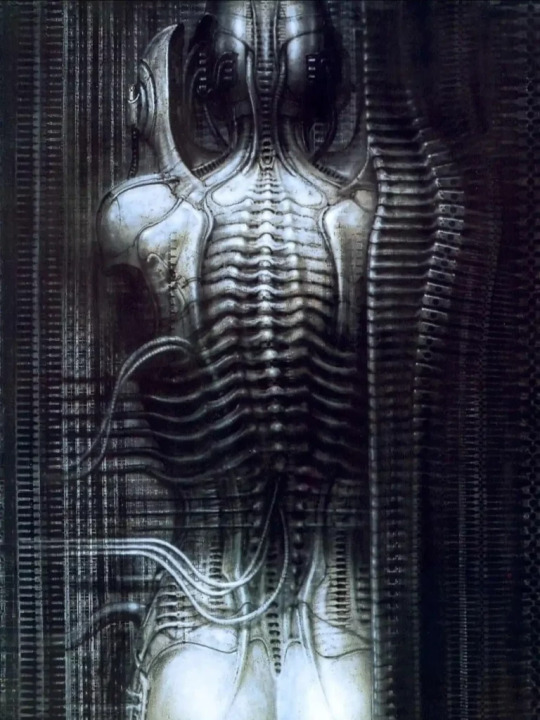
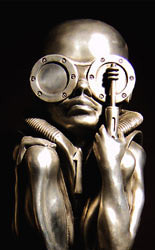



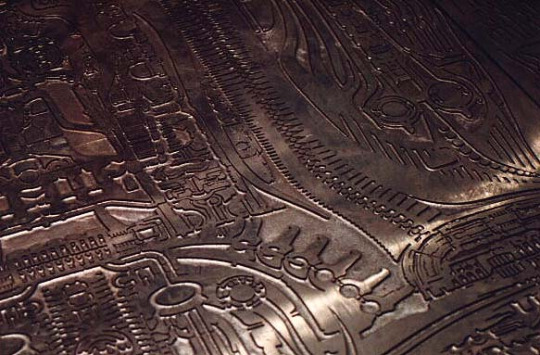
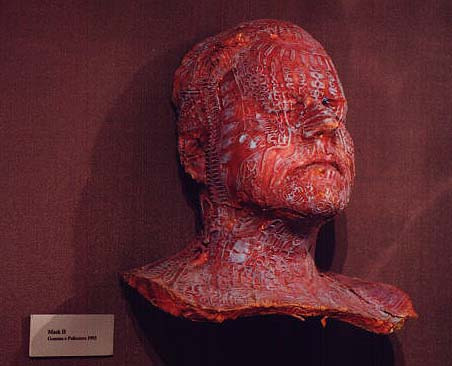


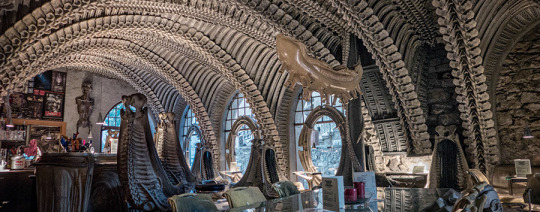
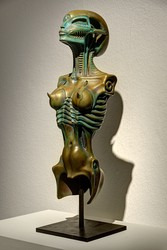



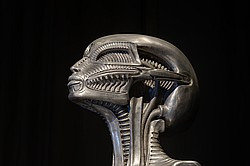


H.R Giger, 1940-2014
(Long) list of works:
1, 2 and 3: What I assume are early versions of the Pisces, Capricorn and Ares statues from Giger's 'zodiac fountain' project, 1996. Pictures by Louis Stalder from https://www.hrgiger.com/zodiac.htm
4 (and 6): The "Harkonnen Chair" series. 1981, created from fibreglass for the never completed film 'DUNE' (dir. Alejandro Jodorowsky). 4 is from https://www.hrgiger.com/chairs.htm (no image credit)
5 (and 28): Giger's microphone stand designed for the band 'Korn', in roughly 2001. 1 of 5 works in that series. (side note the website I found it on through google images is a gaming website that also apparently hosts pictures of Giger's Korn mic stand??) also referred to as 'Nubian Queen' on his website.
6: See 4
7: Concept art of the "space jockey" in 'Alien', 1979. Giger also directed the creation of the alien and set (!!).
8: 'Mirror Image' 1977, airbrush painting.
9. Depiction of the alien life cycle for the 1979 'Alien' film.
10. part IV of Giger's N.Y City portfolio, 'Torso 456'. 1980-1982.
11. One of the 'Birth machine baby' sculptures, inspired by the 1967 drawing "Birthmachine".
12: Part of the 'Erotomechanics' series, 1979.
13: I couldn't find much on this one, on Giger's website it is called 'Bei Sydow-Zirkwitz' and the image I found of it is an (unverified) print being sold online that claims to be an original lithograph/stone print from 1976. Also calls it "Promethius New York city." They seem to be largely the same, I just chose this one for higher quality.
14. 'Homage to S. Beckett I', 1968 (This series is one of my favourites and this one is often linked to Dali's painting 'The Great Masturbator', which I thought was interesting).
15, 16: Photographs by Pino Carafa, from Giger's Nov-Dec 1996 exhibition in Milan. The head has a placard that looks like it reads 'Mask 11', but with a quick look into it I couldn't find a proper name or identification for these pieces except for their presence in the past exhibits on the HR Giger website.
17: 'Drawing for sil/Sil's baby', 1994 (?) a sketch I only found because of the Giger database which is an amazingly detailed and and easy to access record of literally everything Giger ever did, here it is (https://www.littlegiger.com/gigerdb/index.php) the images are tiny however :(
18: Noracyclin (contraceptive-pill) 1965, same source as above - H.R Giger has said this and the 'birthmachine'/baby theme throughout his work are (partly) demonstrations of his fears for the planet due to overpopulation
19: From the page on Giger's website about the bars across the world that use his designs and imagery. The image is an example of the bar in Gruyères, Switzerland, which opened in 2003.
20, 21 and 24: 'Biomechanoid' statues, the one with the green/blue finish created 2010, the silver one 2002.
22: A photograph of H.R Giger and a model from one of the 'Alien' films. From the Giger Work Catalogue, image owned by Matthias Belz, as are 20, 24, 25 and 26.
23: 'The Great Beast', Giger's concept art for the 1985 film 'Poltergeist'.
24: See 20 & 21
25: 'Guardian Angel', sculpture from 2002. Could also be the rusted version.

look here 👆 in particular for more excellent images that will blow your tits clean off
these are just some of my favorites that i wanted other people to know about, his website, catalogue and database have so much more PEACE AND LOVE
13 notes
·
View notes
Text
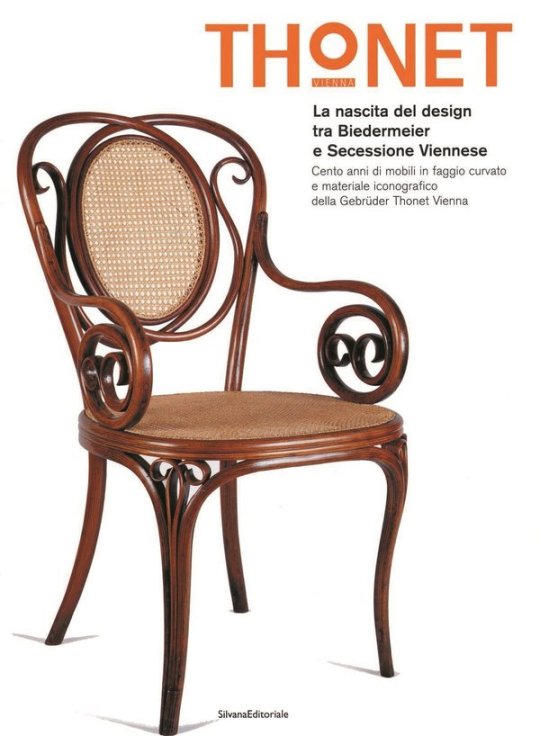





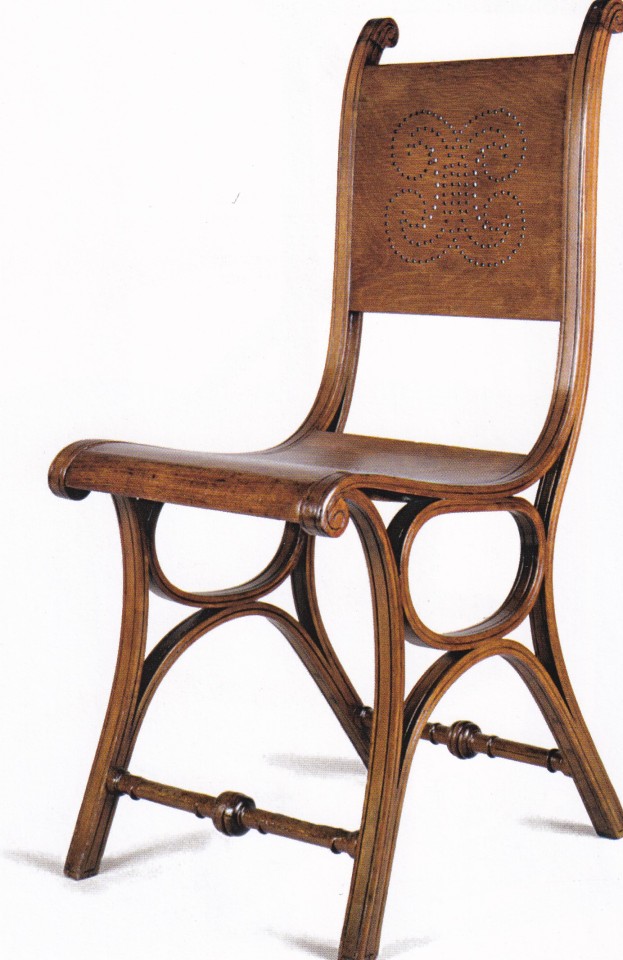



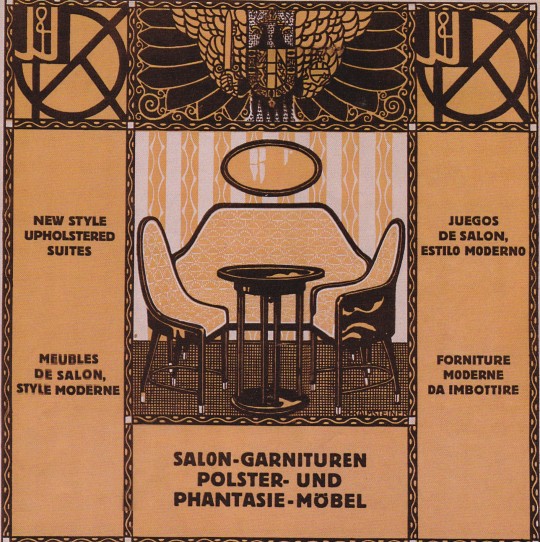
Thonet
La nascita del design tra Biedermeier e Secessione Viennese
Cento anni di mobili in faggio curvato e materiale iconografico della Gebrüder Thonet Vienna
a cura di Chiara Carafa Renzi e Giovanni Renzi, fotografie Studio Cigolini
SilvanaEditoriale, Cinisello Balsamo 2005, 64 pagine, 24x30cm, 40 ill.colori, ISBN 9788882158903
euro 35,00
email if you want to buy [email protected]
La pubblicazione, un agile fascicolo riccamente illustrato, accompagna l’esposizione allestita al Castello Sforzesco di Milano (11 marzo -24 aprile 2005) dedicata a Michael Thonet e alla sua produzione di oggetti di arredamento in legno curvato dalla seconda metà dell’Ottocento fino agli anni venti del Novecento. I modelli di Thonet, che divennero un’icona del design europeo, erano ottenuti utilizzando il legno di faggio curvato al vapore, una tecnologia continuamente perfezionata dalla casa produttrice, che consentiva di piegare le aste di faggio in curve, riccioli e angoli retti, come se fosse un materiale plastico. Ripercorrere la storia delle sedie, delle poltrone, dei tavoli della Gebrüder Thonet significa, come sottolineano i curatori nel saggio introduttivo, addentrarsi nell’origine del design e dell’industria, grazie alla capacità che ebbe Thonet di coniugare la produzione di massa con il gusto artistico e l’innovazione tecnologica.
16712/23
#Thonet#design exhibition catalogue#Castello Sforzesco Milano 2005#Michael Thonet#mobili in legno curvato#Gebrüder Thonet#nascita design#sedie poltrone tavoli#design books#designbooksmilano#fashionbooksmilano
7 notes
·
View notes
Text
Vulgus vult decipi, ergo decipiatur.
Laggente vuole esser ingannata, quindi inganniamola.
Frase attribuita al cardinal Carlo Carafa (XVI Sec.).
La verità fa male. Descrive perfettamente il rapporto INTERDIPENDENTE tra volgo e potere, tra ignoranti e "intellettuali". Simul stabunt ...
7 notes
·
View notes
Text
Una fama sinistra grava sul palazzo situato al n. 9 di piazza San Domenico, a Napoli, dove c’è chi giura di udire nottetempo gemiti e rumori strani, come lo scalpitio concitato di una carrozza o il clangore di catene e ferri battuti.
Proprio all’interno di queste mura, nel 1590, il compositore Carlo Gesualdo, Principe di Venosa, uccise la moglie Maria d’Avalos insieme all’amante don Fabrizio Carafa, sorpresi in flagrante adulterio.
Sempre qui, nel XVIII secolo, visse e operò un personaggio controverso, fuori dal comune persino per gli standard della Napoli settecentesca, che fu al tempo stesso nobiluomo, alchimista, fisico, letterato, medico, esoterico e massone: Raimondo di Sangro, Principe di Sansevero.
Nato il 30 gennaio del 1710 a Torremaggiore, nel Foggiano, Raimondo fu allevato dal nonno dopo che il padre Antonio si ritirò in convento, sconvolto dalla perdita prematura dell’adorata consorte.
Istruito dai Gesuiti del Collegio Romano, dove rimase sino al compimento dei 20 anni d’età, il nostro tornò finalmente a Napoli per risiedere nel palazzo di famiglia.
Piacente, dalla favella pronta, curioso e d’intelligenza superiore alla media, don Raimondo godeva di fantasia illimitata, che amava mettere alla prova con le sue bizzarre invenzioni, come quella di un “lume eterno” realizzato con la polvere ossea derivante dalla triturazione di un teschio umano, ricco di fosfato di calcio e fosforo concentrato.
Meno lugubre fu l’invenzione di un tessuto impermeabile pionieristico per quei tempi, di cui fece dono al Re di Napoli Carlo III di Borbone per la realizzazione di alcuni mantelli da caccia. Fu il suo modo di ringraziare il sovrano per averlo onorato con la prestigiosa nomina a Cavaliere dell’Ordine di San Gennaro.
La famosissima Cappella Sansevero, tuttavia, rimane l’opera che lo ha tramandato ai posteri.
Concepita come luogo di culto, essa costituisce soprattutto un tempio massonico carico di simbologie, perfettamente calzante all’estro e al carisma del Principe di Sansevero che così volle abbellire, ampliandola a suo gusto e somiglianza, un’antica cappella preesistente.
Capisaldi del progetto sono le dieci statue delle “Virtù” addossate ad altrettanti pilastri: nove al femminile, dedicate alle donne di Casa Sansevero, e una sola al maschile, il Disinganno, eretta in onore di don Antonio, padre del Principe.
Ogni statua, carica di significati allegorici, rimanda al mondo della massoneria di cui don Raimondo era Gran Maestro. In particolare la “Pudicizia”, vista come riferimento alla dea egiziana Iside, ci parla dei riti iniziatici di cui la dea stessa era regina.
Il capolavoro più suggestivo dell’intera Cappella, però, è la statua del cd. “Cristo velato”, realizzata da Giuseppe Sammartino. Vi si contempla il Cristo, adagiato su un materasso e ricoperto di un velo perfettamente aderente alla sua fisionomia, tanto che a lungo è circolata la voce secondo la quale il Principe di Sansevero avrebbe insegnato allo scultore la tecnica della calcificazione chimica del tessuto in cristalli di marmo.
Recenti analisi, in realtà, hanno fugato ogni dubbio sul fatto che l’opera sia stata interamente scolpita partendo da un unico blocco marmoreo.
In un ambiente attiguo, destano grande impressione nei visitatori le due “macchine anatomiche” dei corpi, rispettivamente, di un uomo e di una donna completamente scarnificati, nei quali è possibile osservare l’intero sistema circolatorio.
Anche qui, se per la leggenda si tratta dei poveri resti di due servitori del Principe, ammazzati per la bisogna e così ridotti con l’inoculazione di uno speciale liquido capace di trasformare in metallo i vasi sanguigni, la scienza ha concluso che siamo dinnanzi a due scheletri umani sui quali, con mirabile perizia medica, sono stati ricostruiti in metallo tutti i condotti circolatori.
In ogni caso, tanta fu la familiarità di don Raimondo con la morte, considerata come ineluttabile passaggio della vita stessa, che secondo un’altra credenza popolare, sentendosi prossimo alla fine sopraggiunta il 23 marzo del 1771, egli si fece tagliare in pezzi da uno schiavo moro al fine di farsi adeguatamente sistemare dentro la cassa dalla quale, come un dottor Faust napoletano, sarebbe balzato fuori vivo e vegeto a tempo prestabilito.
Sarà anche per questo motivo che non è raro scorgere passanti che, davanti a quello che fu il so palazzo, si fanno ancora il segno della croce, allontanandosi in tutta fretta.
Accompagna questo scritto il “Ritratto di Raimondo di Sangro, Principe di Sansevero”, di Francesco Mura, 1740 circa, Cappella Sansevero, Napoli.
Anche questo è la mia Napoli..
A domani..
Nini
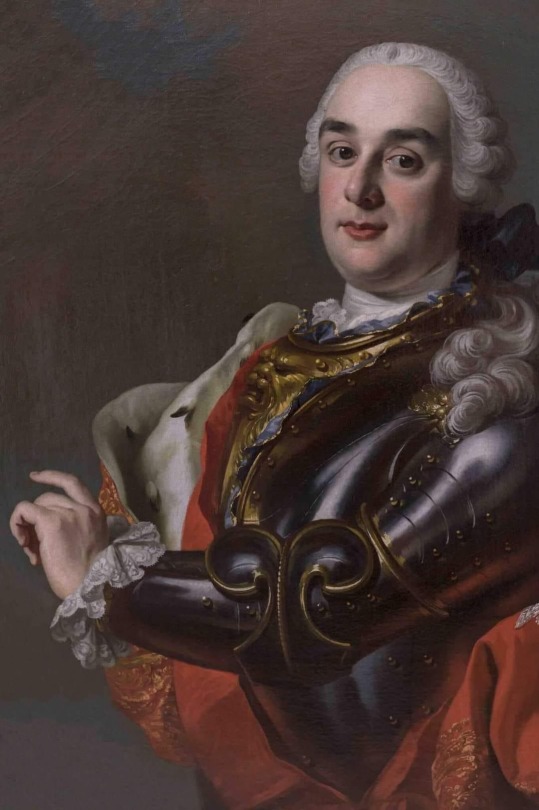
7 notes
·
View notes

